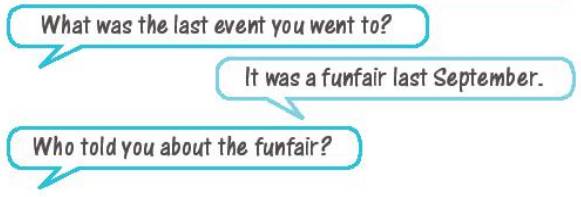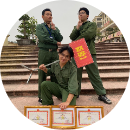Work in groups. One student thinks of any festival he/she likes. Other students ask questions about the festival to find out what festival it is. Remember to use H/Wh-questions and adverbial phrases.

Những câu hỏi liên quan
USE IT! Work in pairs. Ask and answer questions about the events in the box. Use both subject and object questions. concert exhibition festival funfair parade
Đọc tiếp
USE IT! Work in pairs. Ask and answer questions about the events in the box. Use both subject and object questions.
| concert exhibition festival funfair parade |

1 What did you do at the concert?
=> I listened to live music and danced.
2 Who did you meet at the exhibition?
=> I met some talented artists at the exhibition.
3 What did they showcase at the festival?
=> They showcased traditional dances, music, and food at the festival.
4 What activities did you participate in at the funfair?
=> I rode on the Ferris wheel and played carnival games at the funfair.
5 What did they display during the parade?
=> They displayed colorful floats and marching bands during the parade.
Đúng 1
Bình luận (0)
A: Where did you go to the concert last week?
(Tuần trước bạn đã tham gia buổi hòa nhạc ở đâu vậy?)
B: It was held in Ho Chi Minh City.
(Nó được tổ chức ở Thành phố Hồ Chí Minh.)
A: Who did you go with?
(Bạn đã đi cùng với ai?)
B: I went with my Mum. Who did you visit the exhibition about yesterday?
(Hôm qua bạn đã đi tham quan triển lãm về ai vậy?)
A: It was about Vincent van Gogh.
(Nó là về họa sĩ Vincent van Gogh.)
B: Did you participate in a festival?
(Bạn đã từng tham gia một lễ hội chưa?)
A: Yes, I did. It was a carnival.
(Có chứ. Đó là một lễ hội hóa trang.)
B: Who took you there?
(Ai đã đưa bạn đến đó vậy?)
Đúng 0
Bình luận (0)
2. You attended a festival and like it very much.
Write an email to your friend to describe the
festival. The description should be about 70-90
words.
You can use the following questions as cues:
- What is the name of the festival?
- Where is it held?
- When is it held?
- How is it held?
- What do you like most about it?
2. You attended a festival and like it very much.
Write an email to your friend to describe the
festival. The description should be about 70-90
words.
You can use the following questions as cues:
- What is the name of the festival?
- Where is it held?
- When is it held?
- How is it held?
- What do you like most about it?
Read the paragraph, then answer the questionsOne of the festivals in the Buddhist tradition is called Vesak. It takes place in April or May, and it lasts for three days. The festival celebrates the life of Buddha, and it also marks the beginning of the Buddhist year. During the festival, Buddhists decorate their houses and streets with flowers and paper lanterns. They give presents to monks and to poor people, and they send each other cards. In India, they sometimes buy birds in cages and set th...
Đọc tiếp
Read the paragraph, then answer the questions
One of the festivals in the Buddhist tradition is called Vesak. It takes place in April or May, and it lasts for three days. The festival celebrates the life of Buddha, and it also marks the beginning of the Buddhist year. During the festival, Buddhists decorate their houses and streets with flowers and paper lanterns. They give presents to monks and to poor people, and they send each other cards. In India, they sometimes buy birds in cages and set them free.
Questions:
What is Vesak?
……………………………………………………………………………..………………….
Đáp án: Traditional Buddhist festival celebrates the life of Buddha and also marks the beginning of the Buddhist year
Đúng 0
Bình luận (0)
Exercise 5. MIME GAME. Work in groups of three. Write ten sentences on pieces of paper. Use the present continuous, for example, Im having lunch. One student takes a piece of paper and mimes the sentence. The other students ask questions to guess the sentence. The first student to guess the correct sentence mimes the next sentence.(TRÒ CHƠI DIỄN TẢ BẰNG HÀNH ĐỘNG. Làm việc trong nhóm ba người. Viết mười câu trên mảnh giấy. Sử dụng thì hiện tại tiếp diễn, ví dụ, tôi đang ăn trưa. Một học sinh lấy...
Đọc tiếp
Exercise 5. MIME GAME. Work in groups of three. Write ten sentences on pieces of paper. Use the present continuous, for example, I'm having lunch. One student takes a piece of paper and mimes the sentence. The other students ask questions to guess the sentence. The first student to guess the correct sentence mimes the next sentence.
(TRÒ CHƠI DIỄN TẢ BẰNG HÀNH ĐỘNG. Làm việc trong nhóm ba người. Viết mười câu trên mảnh giấy. Sử dụng thì hiện tại tiếp diễn, ví dụ, tôi đang ăn trưa. Một học sinh lấy một tờ giấy và diễn tả câu đó. Các học sinh khác đặt câu hỏi để đoán câu. Học sinh đầu tiên đoán câu đúng diễn tả hành động mô tả câu tiếp theo.)
Are you having dinner? - No, I'm not.
(Bạn đang ăn tối à? – Không.)
Are you having lunch? - Yes, I am!
(Bạn đang ăn trưa hả? – Đúng rồi.)
- Are you reading a book? – No, I’m not.
(Bạn đang đọc sách à? – Không.)
- Are you reading newspaper? – Yes, I am!
(Bạn đang đọc báo à? – Đúng rồi.)
1. I’m running. (Tôi đang chạy.)
2. I’m walking. (Tôi đang đi bộ.)
3. I’m swimming. (Tôi đang bơi.)
4. I’m cooking. (Tôi đang nấu ăn.)
5. I’m writing an email. (Tôi đang viết thư điện tử.)
6. I’m talking on the mobile phone. (Tôi đang nói chuyện qua điện thoại.)
7. I’m listening to music in English. (Tôi đang nghe nhạc tiếng Anh.)
8. I’m watching a football match. (Tôi đang xem trận bóng đá.)
9. I’m doing morning exercise. (Tôi đang tập thể dục buổi sáng.)
10. I’m climbing on a tree. (Tôi đang trèo cây.)
Đúng 2
Bình luận (0)
- Are you reading a book? – No, I’m not.
(Bạn đang đọc sách à? – Không.)
- Are you reading newspaper? – Yes, I am!
(Bạn đang đọc báo à? – Đúng rồi.)
1. I’m running. (Tôi đang chạy.)
2. I’m walking. (Tôi đang đi bộ.)
3. I’m swimming. (Tôi đang bơi.)
4. I’m cooking. (Tôi đang nấu ăn.)
5. I’m writing an email. (Tôi đang viết thư điện tử.)
6. I’m talking on the mobile phone. (Tôi đang nói chuyện qua điện thoại.)
7. I’m listening to music in English. (Tôi đang nghe nhạc tiếng Anh.)
8. I’m watching a football match. (Tôi đang xem trận bóng đá.)
9. I’m doing morning exercise. (Tôi đang tập thể dục buổi sáng.)
10. I’m climbing on a tree. (Tôi đang trèo cây.)
Đúng 1
Bình luận (0)
Work in pairs. Imagine that onl of you is from the USA and the other frm Phu Yen, Viet Nam. Ask and answer questions about Thanksgiving and Hoi Mua, a harvest festival in Phu Yen. Use the information in this lesson and on page 35
A: This photo is so beautiful. Where did you take it?
B: I took it at Hoi Mua festival in my village. Do you have a festival in your country?
A: Sure. Thanksgiving is an example. Why do you celebrate Hoi Mua?
B: In March. Wdiat about Thanksgiving?
A: In November. Why do you celebrate Hoi Mua?
B: We celebrate Hoi Mua to thank the Rice God for the crop and to pray for better crops in the future. Families also worship their ancestors and parents on this occasion.
A: Who takes part in Hoi Mua?
B: Everybody in our village does. What about Thanksgiving? WTio participates in this celebration?
A: Most American families. WTiat do they do in Hoi Mua?
B: They do lots of activities such as playing drums, dancing, drinking rice wine, etc. There are also some cultural activities such as buffalo races, cultural shows and traditional games. Could you tell me some activities in Thanksgiving?
A: We gather to have a feast with turkey. Turkey is the traditional food of Thanksgiving.
B: Wow. I like turkey. Tell me more about...
Bài dịch:
A: Bức hình này đẹp quá. Cậu chụp ở đâu thế?
B: Tớ chụp ở Hội Mùa trong làng tớ. Nước cậu có lễ hội không?
A: Có chứ. Lễ Tạ ơn chẳng hạn. Các cậu tổ chức Hội Mùa khi nào?
B: Vào tháng 3. Thế còn lễ Tạ ơn?
A: Vào tháng 11. Tại sao các cậu tổ chức Hội Mùa?
B: Chúng tớ tổ chức Hội Mùa đê cảm ơn Thần Nông vì đã giúp mùa màng tốt tươi và nguyện cầu cho mùa màng tốt hơn nữa trong tương lai. Các gia đình cũng cầu nguyện cho tổ tiên, cha mẹ trong dịp này.
A: Ai tham gia Hội Mùa?
A: Mọi người trong làng tớ. Thế còn ngày lễ Tạ ơn? Ai tham gia lễ này?
B: Hầu hết các gia đình ở Mỹ. Họ làm gì trong Hội Mùa?
A: Có nhiều hoạt động như chơi trống, nhảy múa, uống rượu cần,v,v... Có cả những hoạt động văn hóa như đua trâu, trình diễn văn hóa và các trò chơi truyền thống. Cậu có thế kể cho tớ vài hoạt động trong ngày lễ Tạ ơn không?
B: Chúng tớ họp mặt và ăn tiệc có món gà tây. Gà tây là món truyền thống của lễ Tạ ơn mà.
A: Chà. Tớ thích gà tây. Kể cho tớ nghe về ...
Đúng 0
Bình luận (0)
Vừa xong đây
A: This picture is beautiful. Where did you take it?
Bức ảnh này thật đẹp. Bạn chụp nó ở đâu vậy?
B: I took it in Hoi Mua festival in my village. Do you have a harvest festival in your country?
Mình chụp nó ở Lễ hội Mưa ở làng mình. Bạn có lễ hội thu hoạch ở quốc gia bạn chứ?
A: Sure. It’s Thanksgiving. When do you celebrate Hoi Mua festival?
Có. Nó là Lễ Tạ ơn. Khi nào bạn tổ chức lễ hội mưa?
B: In March. What about Thanksgiving?
Vào tháng 3. Còn Lễ Tạ ơn?
A: It’s in November.
Nó vào tháng 11.
Đúng 0
Bình luận (0)
Read the paragraph, then answer the questionsOne of the festivals in the Buddhist tradition is called Vesak. It takes place in April or May, and it lasts for three days. The festival celebrates the life of Buddha, and it also marks the beginning of the Buddhist year. During the festival, Buddhists decorate their houses and streets with flowers and paper lanterns. They give presents to monks and to poor people, and they send each other cards. In India, they sometimes buy birds in cages and set th...
Đọc tiếp
Read the paragraph, then answer the questions
One of the festivals in the Buddhist tradition is called Vesak. It takes place in April or May, and it lasts for three days. The festival celebrates the life of Buddha, and it also marks the beginning of the Buddhist year. During the festival, Buddhists decorate their houses and streets with flowers and paper lanterns. They give presents to monks and to poor people, and they send each other cards. In India, they sometimes buy birds in cages and set them free.
What is Vesak?
Traditional Buddhist festival celebrates the life of Buddha and also marks the beginning of the Buddhist year.
Đúng 0
Bình luận (0)
USE IT! Work in pairs. Read the situation, prepare and practise a new dialogue. Use the key phrases and the dialogue in exercise 1 to help you.Student A: Ask your partner what the problem is: he/she looks tired. Listen, find out some more information, then offer some advice.Student B: Youre not sleeping well and youre always tired. Youre worried that your school work is getting worse. You listen to music and text your friends when you should be asleep.
Đọc tiếp
USE IT! Work in pairs. Read the situation, prepare and practise a new dialogue. Use the key phrases and the dialogue in exercise 1 to help you.
Student A: Ask your partner what the problem is: he/she looks tired. Listen, find out some more information, then offer some advice.
Student B: You're not sleeping well and you're always tired. You're worried that your school work is getting worse. You listen to music and text your friends when you should be asleep.
Student A: Ask your partner what the problem is: he / she looks tired. Listen, find out some more information, then offer some advice.
A: Hi, B. Is anything the matter? You look really tired.
B: I'm really concerned about the English course I’m doing. It’s too difficult.
A: Have you spoken to your teachers about it?
B: No. I'm so worried, I haven't told my teacher about it.
A: My advice is to get help now. If you don't, things will only get worse
B: I don’t know what to do.
A: Don’t panic. But you need to speak to someone about it.
B: You're right . I'll go and talk to my teacher now. Thanks, A.
A: No problem.
Student B: You’re not sleeping well and you're always tired. You're worried that your school work is getting worse. You listen to music and text your friends when you should be asleep.
A: Hi, B. Is anything the matter? You look really tired.
B: I'm not sleeping well and I'm always tired.
A: What happened?
B: No. I'm worried about school work is getting worse. I listen to music and text my friends when I'm asleep.
A: My advice is you should go to bed earlier and stay away from your electronic devices.
B: You're right . I'll try to go to bed early. Thanks, A.
A: No problem.
Đúng 1
Bình luận (0)
Read the paragraph, then answer the questionsOne of the festivals in the Buddhist tradition is called Vesak. It takes place in April or May, and it lasts for three days. The festival celebrates the life of Buddha, and it also marks the beginning of the Buddhist year. During the festival, Buddhists decorate their houses and streets with flowers and paper lanterns. They give presents to monks and to poor people, and they send each other cards. In India, they sometimes buy birds in cages and set th...
Đọc tiếp
Read the paragraph, then answer the questions
One of the festivals in the Buddhist tradition is called Vesak. It takes place in April or May, and it lasts for three days. The festival celebrates the life of Buddha, and it also marks the beginning of the Buddhist year. During the festival, Buddhists decorate their houses and streets with flowers and paper lanterns. They give presents to monks and to poor people, and they send each other cards. In India, they sometimes buy birds in cages and set them free.
Questions:
When is Vesak celebrated?
…………………………………………………………………………………………………
















